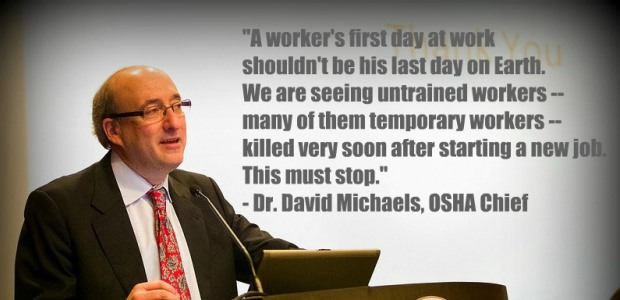
Page 2 of 1
OSHA Civil Penalties Rising in August
ATLANTA -- In what may have been his final speech as assistant secretary of OSHA before attendees of an ASSE annual conference, Dr. David Michaels spelled out several regulatory initiatives he said the agency will undertake during his final months in the job. OSHA's civil penalties will be increased to account for inflation, effective in August but announced next week, he said June 28 at Safety 2016, as he listed the new penalties:
- Serious and other-than-serious violation penalties, now at $7,000, will rise to $12,471
- Willful and repeat, now at $70,000, will rise to $124,709
- Failure to abate, now at $7,000 per day, will increase to $12,741 per day
He reminded the audience that a bipartisan Congress authorized the increases and said OSHA will adjust the maximum penalty amounts annually for inflation from now on.
OSHA still plans to issue a walking/working surfaces final rule, will issue a noise in construction NPRM, is about to start a Safety & Health Program (SHP) national campaign with the slogan "SAFE Workplace SOUND Business," and on July 13 will be holding a tree care stakeholder meeting in Washington, D.C., as it launches "a regulatory effort to protect tree care workers," Michaels announced.
He again discussed the rule that requires employers to timely report any worker's amputation injury, any hospitalization of a worker, and every loss of an eye -- saying, as he has on previous occasions, that "This engages thousands of employers who normally wouldn't be talking to OSHA, and we think that's a good thing." OSHA responded with what Michaels called "rapid response investigations" in 62 percent of the 10,388 cases that were reported by employers according to the rule in the first year it was in effect, meaning it contacted those employers but did not initiate an inspection, and the employer took actions to prevent additional serious injuries. OSHA's penalty for not reporting such an injury as required has been a $1,000 fine, but it is rising to $5,000 and can go to $7,000 depending on the situation, he said.
He said employers will be required to post a new OSHA poster effective Aug. 10, 2016. The new version will state that employees have the right to report work-related injuries and that employers may not retaliate against workers who do report an injury. This is related to the reporting mandate OSHA recently enacted that will see 400,000 employers' summary injury logs posted online by OSHA, with identifying information removed. Michaels said the rule requires employers to have reporting procedures in place that are reasonable and do not discourage employees from reporting injuries; asked by an audience member about the rule's text on drug testing programs, he explained that retaliatory drug testing -- testing that is done only after a worker is hurt on the job, for example -- discourages employees from reporting injuries and thus runs afoul of the rule.
Employers have raised concern about the rule's impact on drug testing programs and also on safety incentive programs. Incentives based on injury rates or going a specified period of time without a lost-time injury also are a concern for OSHA, Michaels said.
One of the final questions concerned what he's thinking as his tenure nears its end -- Michaels has held the position longer than any of his predecessors, as this point -- and what advice he'd give to the next OSHA assistant secretary. "I've just enjoyed this job tremendously," he said, adding that he'd tell his successor that OSHA has to use all of its approaches -- rulemaking, compliance assistance, etc. -- and use them well, and he'd like to see its budget doubled or tripled from what it is today.